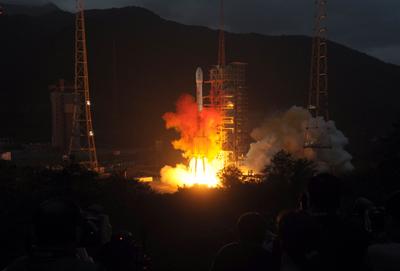China-Pakistan cooperation in space technology spans over two decades. In 1990 Pakistan launched its first indigenously-developed satellite, Badar-1, from China. A year later they formally signed an agreement to enhance cooperation for peaceful applications of space technologies, and various other agreements in the same vein have ensued.
The agreement to develop Paksat-1R was finalised in October 2008. For its completion, Beijing provided Pakistan with a RMB 222 million (US$34.7 million) loan. And in October 2010, Pakistan signed a contract with the EXIM Bank of China to obtain an additional RMB 86.5 million (US$13.5 million) concessional loan.
Pakistan stated that the launch of Paksat-1R would ‘revolutionise’ the use of broadband internet, digital television broadcasting and rural telephony, as well as spur the economy, strengthen the education and health sector, and help increase disaster preparedness (a priority after the devastating 2010 floods). Some analysts suggest the satellite will also provide strategic advantages to Pakistan’s armed forces. But most importantly, young Pakistani scientists gained first-hand experience by working alongside Chinese counterparts. This experience will go a long way in Pakistan’s space sciences research, with Sino-Pakistani space cooperation seeking to cover climate science, clean-energy technologies, clean-water technologies, cyber-security, and other sciences across the board.
Pakistan’s space agency (the Space and Upper Atmosphere Research Commission: SUPARCO), plans to launch an optical satellite by the end of the year, and a high-resolution Remote Sensing Satellite System in 2014. Pakistan even intends to eventually build its own spaceship as well — with China’s help. Pakistan’s Ambassador to China, Masood Khan, stated that it was his country’s desire that the first foreign astronaut aboard a Chinese spacecraft be a Pakistani, alluding to the future level of their cooperation. And analysts do not rule out the future possibility of a Pakistani astronaut flying with Chinese counterparts for space missions.
China and Pakistan are also connected through a multilateral forum on space cooperation. In 1992, China, Pakistan and Thailand signed a memorandum of understanding for Asia Pacific Multilateral Cooperation in Space Technology and Applications (AP-MCSTA). Then in October 2005, these countries along with Bangladesh, Indonesia, Iran, Mongolia and Peru signed a convention to establish Asia-Pacific Space Cooperation Organization (APSCO) for the cooperation and promotion of space knowledge within the member countries and the Asia-Pacific region. Several regional and extra-regional countries are now affiliated with APSCO.
China will also gain a lot from its cooperation with Pakistan. From a commercial perspective, space technology is an emerging market in which China is gaining an advanced level of expertise. By 2020, the market value of the navigation and satellite industry is expected to exceed US$400 billion, and China intends to grab a share. The Chinese government has pushed its state-owned telecommunication companies to go overseas for commercial deals. These companies offer competitive prices, soft loans to finalise deals, training for local scientists and technology transfer. It was not surprising then that, a week before the launch of Paksat-1R, China’s space program clinched a US$294 million agreement with Bolivia to build and launch a satellite for that country. Against this backdrop, China will showcase the success of its cooperation with Pakistan to attract other developing countries and gain direct financial benefits from any deal with Pakistan.
There is a military dimension to this cooperation as well. Although China-Pakistan cooperation in space technology is ostensibly only for peaceful purposes, its defence implications cannot be ruled out. SUPARCO is closely linked with Pakistan’s other organisations such as the Kahuta Research Laboratories (KRL), responsible for Pakistan’s missiles program. The US-imposed sanctions against Pakistan over the clandestine development of its nuclear and missile program during the 1990s effectively included a sanction on SUPARCO. So the current China-Pakistan cooperation in space technology might raise concerns with the US, and possibly India.
Regardless of how other states respond, China-Pakistan space cooperation is timely and mutually beneficial. China is looking for a market for its growing space expertise. And Pakistan needs assistance with soft loans, training of its scientists and know-how in space sciences. This cooperation adds a new dimension to their already robust relationship. It brings Pakistan closer to China than ever before.
Ghulam Ali is on the Taiwan Fellowship at the Institute of International Relations, National Chengchi University, Taipei.

